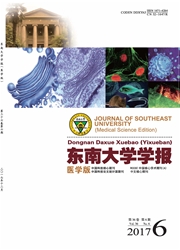

 中文摘要:
中文摘要:
目的:建立免疫性内耳病(IMIED)模型,并检测内耳干扰素-γ(IFN-γ)表达的变化情况。方法:将20只豚鼠按配对设计方法分为实验组和对照组。实验组采用钥孔戚血蓝蛋白(KLH)在已致敏的豚鼠圆窗龛局部免疫,对照组用PBS代替KLH免疫豚鼠;观察血清中特异性KLH抗体水平、听觉功能及内耳病理形态变化,并行酶免疫组化试验观察内耳IFN-γ的表达。结果:实验组免疫前后ABRⅢ波阈值的均值差异有统计学意义(P〈0.05),免疫后实验组有7只动物(12耳)出现听损,且血清中特异性KLH抗体水平较免疫前明显升高(P〈0.05);对照组免疫前后ABRⅢ波阈值的均值和血清KLH抗体水平的差异均无统计学意义(P〉0.05);免疫后实验组ABRⅢ波阈值的均值和血清KLH抗体水平均高于对照组(P〈0.05)。实验组免疫后内耳组织中有炎症细胞浸润,部分豚鼠内耳有迷路积水。对照组豚鼠内耳组织中无明显IFN-γ表达,实验组IFN-γ表达主要分布在血管纹、螺旋韧带、螺旋神经节、Corti器及蜗轴小血管周围。结论:在已致敏的豚鼠圆窗龛局部免疫,诱导并造成IMIED模型的成功率较高。正常豚鼠内耳中几乎没有IFN-γ表达,而在IMIED豚鼠内耳中IFN-γ有显著表达,提示IMIED发生发展可能与IFN-γ表达有关。
 英文摘要:
英文摘要:
Objective: To establish a model of immune-mediated inner ear disease(IMIED) and to study the change of interferon-γ(IFN-γ) expression in the inner ear.Methods: Twenty guinea pigs were divided into experimental group and control group with paired design.The round windows of systemically pre-sensitized guinea pigs were locally immunized with keyhole limpet hemocyanin(KLH) in experimental group and PBS in the control group.Then the anti-KLH level and auditory function were determined before immunization and at 2 weeks after immunization.Tissue paraffin sections of temporal bone was made and observed by microscopy,and IFN-γ expression in the inner ears of all guinea pigs was detected by immunohistochemical test after immunization.Results: There were significant differences in the mean value of the threshold of ABRⅢ wave before and after immunization of the experimental group(P〈0.05).Judging from mean value plus 2 times of the standard deviation(41.10 dB) of all the guinea pigs for the experiment before immunization,7 animals(12 ears) testified hearing loss and the anti-KLH level of their blood increased significantly compared with before immunization(P〈0.05).There were no significant differences in the mean of the threshold of ABRⅢwave and the serum specific anti-KLH level before and after immunization in the same guinea pigs from the control group(P〉0.05).The mean of the threshold of ABRⅢ wave and the serum specific anti-KLH level were higher in the experimental group than the data in the control group with the significant differences(P〉0.05).There was inflammatory cell infiltration in the inner ears of the guinea pigs after immunized among the experimental group through the observation of the inner ear paraffin section lens and the labyrinthine hydrops in the inner ears of the part of the guinea pigs.Immunohistochemical tests showed that almost no immunoreactivity for IFN-γ was detected in the inner ears of the control group, and the IFN-γ immunoreactivit
 同期刊论文项目
同期刊论文项目
 同项目期刊论文
同项目期刊论文
 期刊信息
期刊信息
